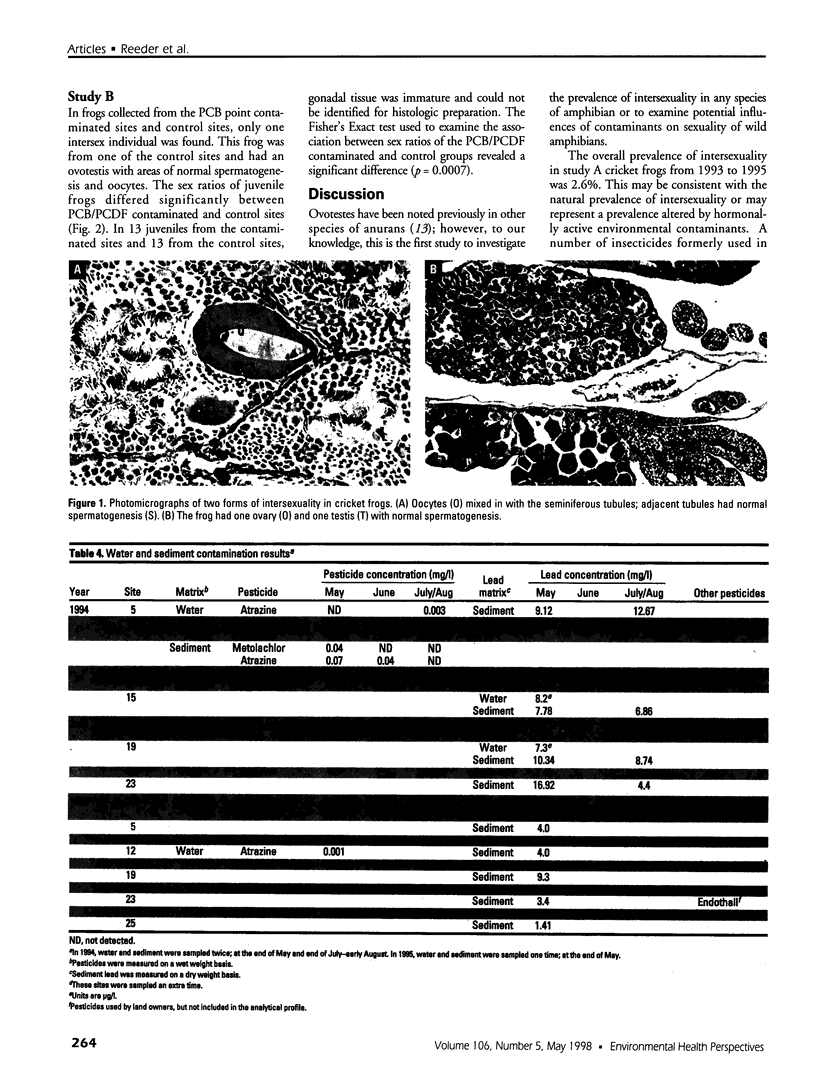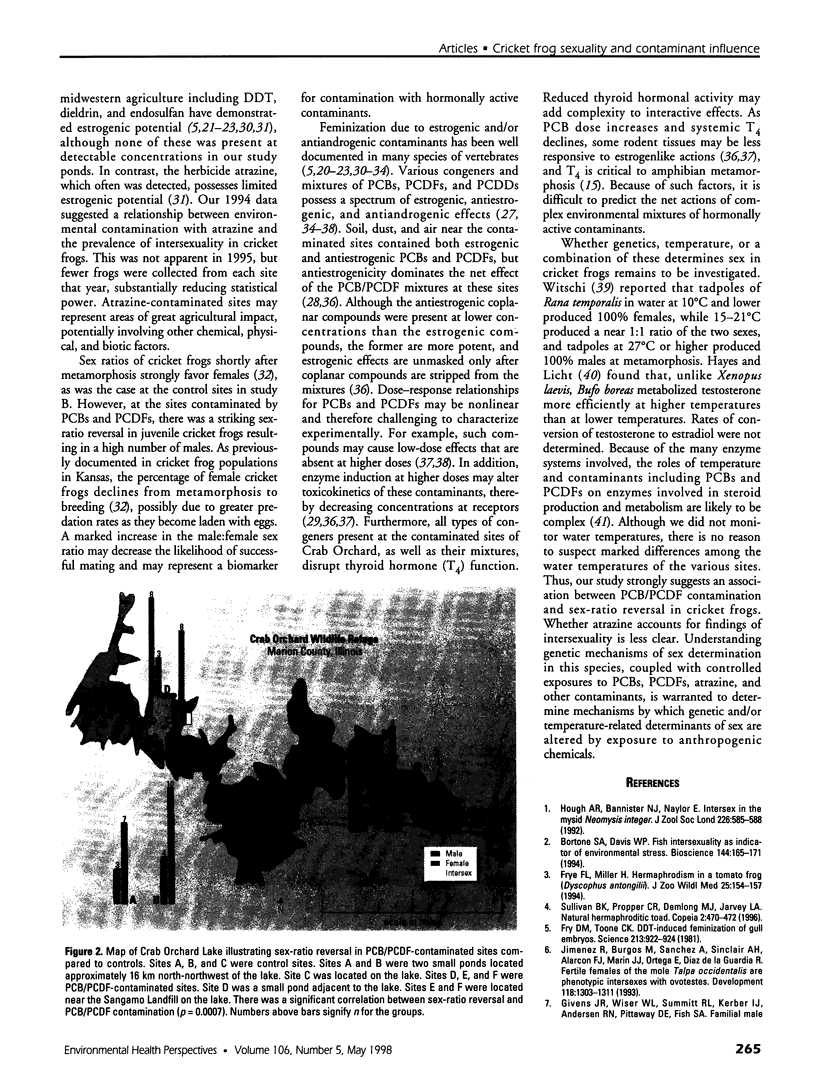Abstract
Cricket frogs (Acris crepitans) from several different sites in Illinois were collected to assess the effects of environmental contamination on the prevalence of intersex gonads. Of 341 frogs collected in 1993, 1994, and 1995, 2.7% were intersex individuals. There was no statistically significant relationship between the chemical compounds detected and cricket frog intersexuality. However, there was an association approaching significance (p = 0.07) between the detection of atrazine and intersex individuals. A comparison of reference sites with sites that had point polychlorinated biphenyl (PCB) and polychlorinated dibenzofuran (PCDF) contamination revealed a significant relationship between sex-ratio reversal and contamination with PCBs and PCDFs. The sex ratio of juvenile frogs studied from three sites with PCB and PCDF point contamination favored males over females, which was the opposite of the sex ratio in control ponds (p = 0.0007). The statistically significant correlation between organochlorine contamination and sex-ratio reversal suggests PCBs and PCDFs can influence cricket frog sexual differentiation. The current study suggests that in cricket frogs, sex ratios and the prevalence of intersex gonads are altered by environmental contamination.
Full text
PDF





Images in this article
Selected References
These references are in PubMed. This may not be the complete list of references from this article.
- Arnold S. F., Klotz D. M., Collins B. M., Vonier P. M., Guillette L. J., Jr, McLachlan J. A. Synergistic activation of estrogen receptor with combinations of environmental chemicals. Science. 1996 Jun 7;272(5267):1489–1492. doi: 10.1126/science.272.5267.1489. [DOI] [PubMed] [Google Scholar]
- Crews D., Bergeron J. M. Role of reductase and aromatase in sex determination in the red-eared slider (Trachemys scripta), a turtle with temperature-dependent sex determination. J Endocrinol. 1994 Nov;143(2):279–289. doi: 10.1677/joe.0.1430279. [DOI] [PubMed] [Google Scholar]
- Eldridge J. C., Tennant M. K., Wetzel L. T., Breckenridge C. B., Stevens J. T. Factors affecting mammary tumor incidence in chlorotriazine-treated female rats: hormonal properties, dosage, and animal strain. Environ Health Perspect. 1994 Dec;102 (Suppl 11):29–36. doi: 10.1289/ehp.94102s1129. [DOI] [PMC free article] [PubMed] [Google Scholar]
- Fry D. M., Toone C. K. DDT-induced feminization of gull embryos. Science. 1981 Aug 21;213(4510):922–924. doi: 10.1126/science.7256288. [DOI] [PubMed] [Google Scholar]
- Guillette L. J., Jr, Gross T. S., Masson G. R., Matter J. M., Percival H. F., Woodward A. R. Developmental abnormalities of the gonad and abnormal sex hormone concentrations in juvenile alligators from contaminated and control lakes in Florida. Environ Health Perspect. 1994 Aug;102(8):680–688. doi: 10.1289/ehp.94102680. [DOI] [PMC free article] [PubMed] [Google Scholar]
- Hayes T. B., Licht P. Factors influencing testosterone metabolism by anuran larvae. J Exp Zool. 1995 Feb 1;271(2):112–119. doi: 10.1002/jez.1402710206. [DOI] [PubMed] [Google Scholar]
- Jansen H. T., Cooke P. S., Porcelli J., Liu T. C., Hansen L. G. Estrogenic and antiestrogenic actions of PCBs in the female rat: in vitro and in vivo studies. Reprod Toxicol. 1993 May-Jun;7(3):237–248. doi: 10.1016/0890-6238(93)90230-5. [DOI] [PubMed] [Google Scholar]
- Jiménez R., Burgos M., Sánchez A., Sinclair A. H., Alarcón F. J., Marín J. J., Ortega E., Díaz de la Guardia R. Fertile females of the mole Talpa occidentalis are phenotypic intersexes with ovotestes. Development. 1993 Aug;118(4):1303–1311. doi: 10.1242/dev.118.4.1303. [DOI] [PubMed] [Google Scholar]
- Kelce W. R., Stone C. R., Laws S. C., Gray L. E., Kemppainen J. A., Wilson E. M. Persistent DDT metabolite p,p'-DDE is a potent androgen receptor antagonist. Nature. 1995 Jun 15;375(6532):581–585. doi: 10.1038/375581a0. [DOI] [PubMed] [Google Scholar]
- Labarrere C. A., Faulk W. P. Antigenic identification of cells in spiral artery trophoblastic invasion: validation of histologic studies by triple-antibody immunocytochemistry. Am J Obstet Gynecol. 1994 Jul;171(1):165–171. doi: 10.1016/0002-9378(94)90464-2. [DOI] [PubMed] [Google Scholar]
- Li M. H., Hansen L. G. Enzyme induction and acute endocrine effects in prepubertal female rats receiving environmental PCB/PCDF/PCDD mixtures. Environ Health Perspect. 1996 Jul;104(7):712–722. doi: 10.1289/ehp.96104712. [DOI] [PMC free article] [PubMed] [Google Scholar]
- Li M. H., Hansen L. G. Responses of prepubertal female rats to environmental PCBs with high and low dioxin equivalencies. Fundam Appl Toxicol. 1996 Oct;33(2):282–293. doi: 10.1006/faat.1996.0166. [DOI] [PubMed] [Google Scholar]
- Li M. H., Zhao Y. D., Hansen L. G. Multiple dose toxicokinetic influence on the estrogenicity of 2,2',4,4',5,5'-hexachlorobiphenyl. Bull Environ Contam Toxicol. 1994 Oct;53(4):583–590. doi: 10.1007/BF00199030. [DOI] [PubMed] [Google Scholar]
- Mably T. A., Bjerke D. L., Moore R. W., Gendron-Fitzpatrick A., Peterson R. E. In utero and lactational exposure of male rats to 2,3,7,8-tetrachlorodibenzo-p-dioxin. 3. Effects on spermatogenesis and reproductive capability. Toxicol Appl Pharmacol. 1992 May;114(1):118–126. doi: 10.1016/0041-008x(92)90103-y. [DOI] [PubMed] [Google Scholar]
- Pfeffer A., Winter H. Hermaphrodites in australian pigs. Occurrence and morphology in an abattoir survey. Aust Vet J. 1977 Apr;53(4):153–162. doi: 10.1111/j.1751-0813.1977.tb00155.x. [DOI] [PubMed] [Google Scholar]
- Walsh P. C., Madden J. D., Harrod M. J., Goldstein J. L., MacDonald P. C., Wilson J. D. Familial incomplete male pseudohermaphroditism, type 2. Decreased dihydrotestosterone formation in pseudovaginal perineoscrotal hypospadias. N Engl J Med. 1974 Oct 31;291(18):944–949. doi: 10.1056/NEJM197410312911806. [DOI] [PubMed] [Google Scholar]
- White R., Jobling S., Hoare S. A., Sumpter J. P., Parker M. G. Environmentally persistent alkylphenolic compounds are estrogenic. Endocrinology. 1994 Jul;135(1):175–182. doi: 10.1210/endo.135.1.8013351. [DOI] [PubMed] [Google Scholar]




